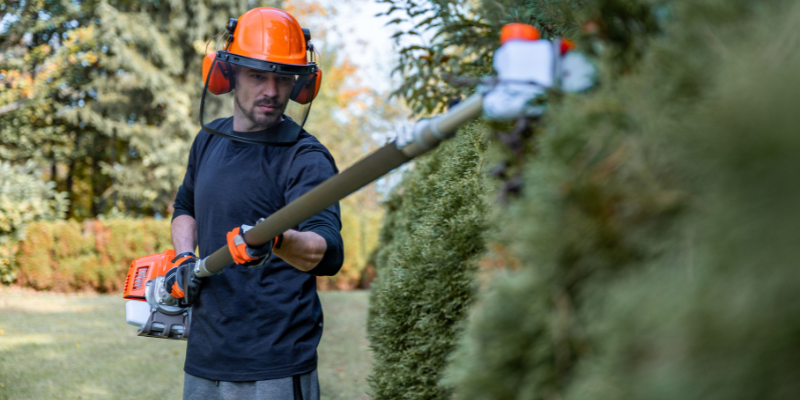8 expert tips for choosing the right tool in landscaping and arboriculture

Landscapers and arboriculture workers have many options when it comes to choosing the best tool for the job, particularly with new technology emerging each season. However, instead of selecting the most appropriate tool for the task, workers often use whatever tool is available or already on-site. “This is especially true if workers have not been given specific training and instruction on which tool to use for which task,” says Ryan Dick, Health and Safety Consultant with Workplace Safety & Prevention Services (WSPS).
“Using the wrong tool can increase a worker’s risk of injury. We’re talking about things like a fall from heights, a serious cut from a blade, or electrocution that can cause potentially critical injuries or fatalities,” explains Ryan.
Your hazard assessment, or job safety analysis, provides key information to help you select the right tool for the job. “This is part of the supervisor’s responsibilities in the planning stages before any work begins,” says Ryan. Once you have broken down each task involved in completing the job and have identified the associated hazards, you can use this information to determine the best tool.
For example, telescopic trimmers allow workers to trim a tall tree or bush while staying on the ground, which is generally safer than working at heights. However, telescopic trimmers pose a hazard to others who are working within a certain radius. They are also not the best tool when there could be hidden electrical hazards near the area being trimmed. “This is the type of information the supervisor needs before they can determine which tool to use for a task,” notes Ryan.
“In addition to identifying the associated hazards, supervisors must also consider the specific worker who will use a tool when assigning a task,” says Ryan, referring to factors such as the size and strength of the worker, both of which can impact the worker’s ability to use a tool safely. Whether a worker is right-handed or left-handed is another piece of information the supervisor should know before assigning them to use a certain tool. “Never ask a worker to use a tool or machine without proper training, and always verify their capabilities before starting the job,” cautions Ryan, as a reminder that the employer is responsible for providing and verifying training.
8 expert tips for selecting the right tool
Sean Hooper is a Health and Safety Training Consultant with the Infrastructure Health and Safety Association (IHSA). Like Ryan, Sean has seen what can go wrong when you do not have the right tools. “The right tool is always the safest tool for the job,” says Sean. He offers this expert advice to help supervisors and workers make the best choice.
- Stay on the ground as much as possible. If the job can be done safely with telescopic equipment, use it. Eliminate the hazard of working at heights whenever you can.
- Locate overhead and underground powerlines before work begins. “Don’t take the homeowner’s or property manager’s word for it. Do your own due diligence by contacting the local utility and Ontario One Call,” notes Sean. Having this information will help you determine the safest way to get the job done.
- When using telescopic equipment (e.g., pole trimmers), ensure other workers are at least 15 metres away. If a worker’s hand slips while using telescopic trimmers, it could cause serious injuries to anyone working close by. Follow the manufacturer’s instructions when using this type of equipment. Most will indicate how far away other workers need to be for their safety.
- Do not use a ladder as a work platform. Step ladders and extension ladders are not designed to be work platforms. “Step ladders and extension ladders are meant for access and egress. They require the worker to maintain three-point contact, which is difficult to do when you have tools in your hands,” Sean explains. In some cases, a platform ladder with a large standing area designed for workers to use both of their hands to complete a task may be appropriate. However, if you have determined that the safest way to complete the job is to do it from a height, consider using a mobile elevated work platform (MEWP). “Remember that workers need documented training before they can use this type of equipment,” he adds.
- Do not use a chainsaw to clear low-level brush. The kickback from the chainsaw increases the risk of severe cuts to the worker’s legs. Instead, use a brush trimmer to clear low-level brush.
- Provide personal protective equipment (PPE) that fits properly. “Most PPE is not ‘one size fits all,” says Sean. PPE must be properly fitted to the worker.
- Inspect all tools and equipment before use. Make sure your workers are trained on how to inspect equipment and identify defects. This includes ladders and extension cords. Do not assume something is in good working order.
- Always verify training. Workers need training on each specific tool or piece of equipment they will be asked to use, and that training must be documented.
Find out more
- Watch this short video on Preventing Falls in Landscaping & Arboriculture Safe Use of Tools, Ladders and Protective Equipment (WSPS and IHSA video).
- Visit the WSPS Landscaper and Arborist Safety Centre for training options, compliance information, and free resources.
- Connect with a WSPS expert for assistance with hazard assessment and tool selection.
Specialized training from IHSA
- Electrical and Utility Safety Rules Training (2024)
- Utility Worker Protection Code (UWPC) Training
- Utility Line Clearing Technician Proficiency Training
- Working at Heights (WAH) - Fundamentals of Fall Prevention (2024)
- Line Clearing - Safety and Awareness (2024)
Resources from WSPS
- Tailgate Talks for the Landscape Industry
- Arborist Industry Safe Work Practices Guide
- Working on Ladders and at Heights Video
- Safety Check: Step Ladder Safety Tips
- Ladder Safety eCourse
The information in this article is accurate as of its publication date.




